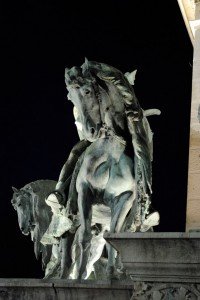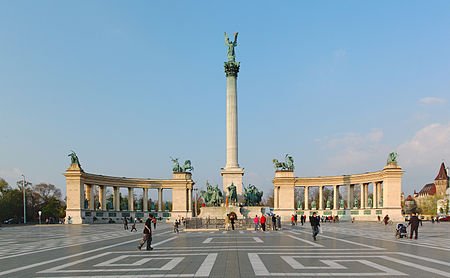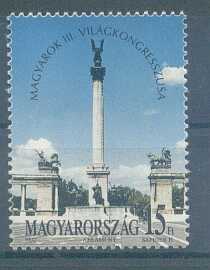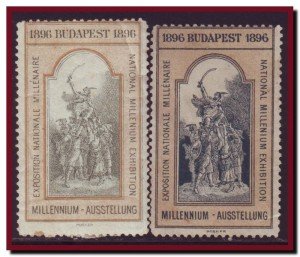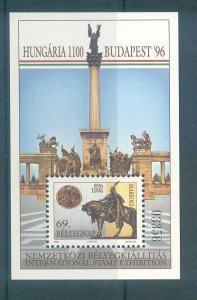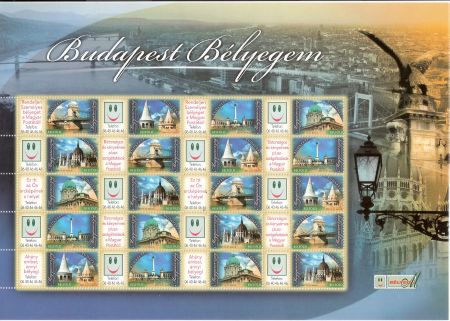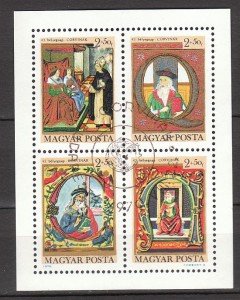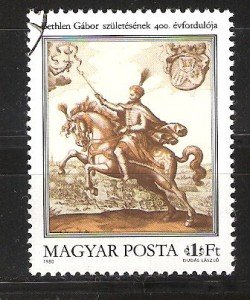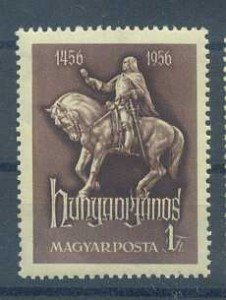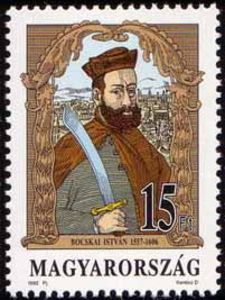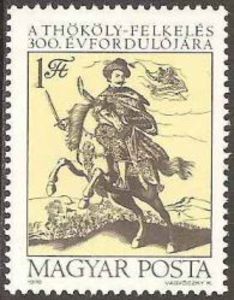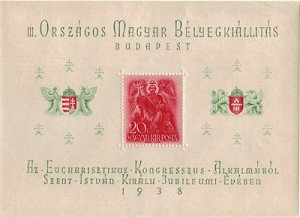Heroes Square (“Hosok Tere” in Hungarian) is a site of great importance in Budapest and is the topic of several stamps depicting both the Square and the Millennium Monument. The monument construction was started in 1896 and completed in the year 1900. It symbolizes the 1000th anniversary of the founding of Hungary in 896 when the seven Hungarian tribes led by Prince Arpad rode into Hungary and settled there. The Square also marks the entrance to the massive Millennium Exhibition of 1896 which was a year-long exhibit that heralded to the world how far Hungary had progressed since the turmoils of the mid-1800’s. The Millennium Exhibition encompassed an area of 4,850 square meters and had 234 pavilions, with over 14,000 exhibits of Hungarian and International organizations. The year 1896 demonstrated Hungarian self-confidence and confirmed that Hungary could take its place among international powers. This was truly a golden age for Hungary.
The Millennium Monument was built in Heroes Square. The square is of great significance in Hungarian history depicting the great “heroes” in the cenotaph (“empty tomb”) surrounding the Monument which commemorates them. The central core of Heroes Square is the monument consisting of the equestrian group commemorating the seven conquering tribal chieftans who accompanied Prince Arpad. To the left and right of the Monument are 14 statues arranged in a semi-circle around the statue of Prince Arpad. Of these only then statue of St. Stephen remains in it’s original place. Becuase the Square was built during the reign of the Hapsburgs their statues occupied a significant portion of the square. The statues of the Habsburgs were replaced after World War II by great people of Hungarian history like Lajos Kossuth to reflect what was truly important to the Hungarian people.
Today the personages of statues in Heroes Square in chronological order are:
Stephen I – St. Stephen became the first king of Hungary in the year 1000. He received the Holy Crown (“Szent Korona”) from the Pope.
Ladislaus I – St. Ladislaus I reigned from 1077 to 1095 and conquered Croatia for Hungary in the year 1091. Under his reign Hungary returned to the glories last know under St. Stephen.
Coloman – King of Hungary from 1095 to 1106, was one of the most educated rulers of his time. He prohibited the burning of witches which was commonplace prior to his reign.
Andrew II – (1196-1235) led the 5th crusade to the Holy Land setting up the largest army in the history of the Crusades (20,000 knights and 12,000 castle-garrisons). He enacted the “Golden Bull” which became the pillar of national pride in establishing freedom and civil liberties over the centuries.
Béla IV – (1235 – 1270) rebuilt the country after the Mongol invasion of 1241 and constructed hundreds of stone forts which were used to repulse the Mongol invasion of 1286 and destroy much of the Mongol invading force.
Charles I – (1308 – 1342) reestablished the crown’s authority by ousting disloyal princes and distributing their estates to his supporters.
Louis I – Louis the Great (1342 – 1382) led many successful military campaigns from Lithuania to southern Italy (Naples) and was made King of Poland. In 1351 he reconfirmed the “Golden Bull” and the economy flourished under his reign.
Janos Hunyadi – became one of the country’s most powerful lords in the 1400’s. He led a crusade against the Turks winning the Battle of Belgrade (1456) and defending the city against the onslaught of the Ottoman Sultan Mehmed II.
Matthias Corvinus – (1458 – 1490) was the last strong king of medieval Hungary. His library, the Biblioteca Coviniana was Europe’s greatest collection of Historical chronicles, philosophic and scientific works of the 15th century.. His army, an unusually large one for it’s time defeated the Ottoman and Wallachian armies
István Bocskay – negotiated the Peace of Vienna in 1606 which guaranteed constitutional and religious rights and privileges of all Hungarians both in Transylvania and Hungary
Gabriel Bethlen – (1613 – 1629) conducted a famous Wallachian campaign in 1613 and concluded a treaty with Bohemia. He was one of the most striking personages of his century. He was called the Hungarian Machiavelli.
Imre Thököly – was a Hungarian statesman and rebel leader from 1670 to 1699. He was the leader of anti-Habsburgs uprisings and won the battle of Szikszó in 1679. He was recognized as a prince ruling the Principality of Upper Hungary.
Ferenc Rákóczi – led an uprising to take control of the government in 1703 – 1707, temporarily dethroned the Hapsburgs in 1707 and took control of the government. He was Prince of Transylvania and today is considered a national hero in Hungary.
Lajos Kossuth – was known as one of Hungary’s most significant freedom fighters. He rallied the peasants of the Great Plain, emerging as the popular leader and becoming the president of the reformed Hungary on March 15, 1848. In 1849 the Hungarian parliament enacted the first laws of ethnic and minority rights in the world.
Stamps of Heroes Square –
There are only a few stamps depicting Heroes Square, but there are many stamps depicting the actual heroes found on the square. In 1896 a series of seals (not used for mailing) were issued to commemorate the Millennium exhibition and were attached to letters mailed from the Exhibition grounds. The first stamp was issued in 1992 and is illustrated. The most beautiful is the “Emlekiv” (specialty sheet) that is also illustrated.
Here are some of the heroes on stamps:
